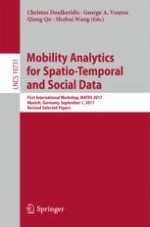2018 | Buch
Mobility Analytics for Spatio-Temporal and Social Data
First International Workshop, MATES 2017, Munich, Germany, September 1, 2017, Revised Selected Papers
herausgegeben von: Christos Doulkeridis, George A. Vouros, Qiang Qu, Shuhui Wang
Verlag: Springer International Publishing
Buchreihe : Lecture Notes in Computer Science
